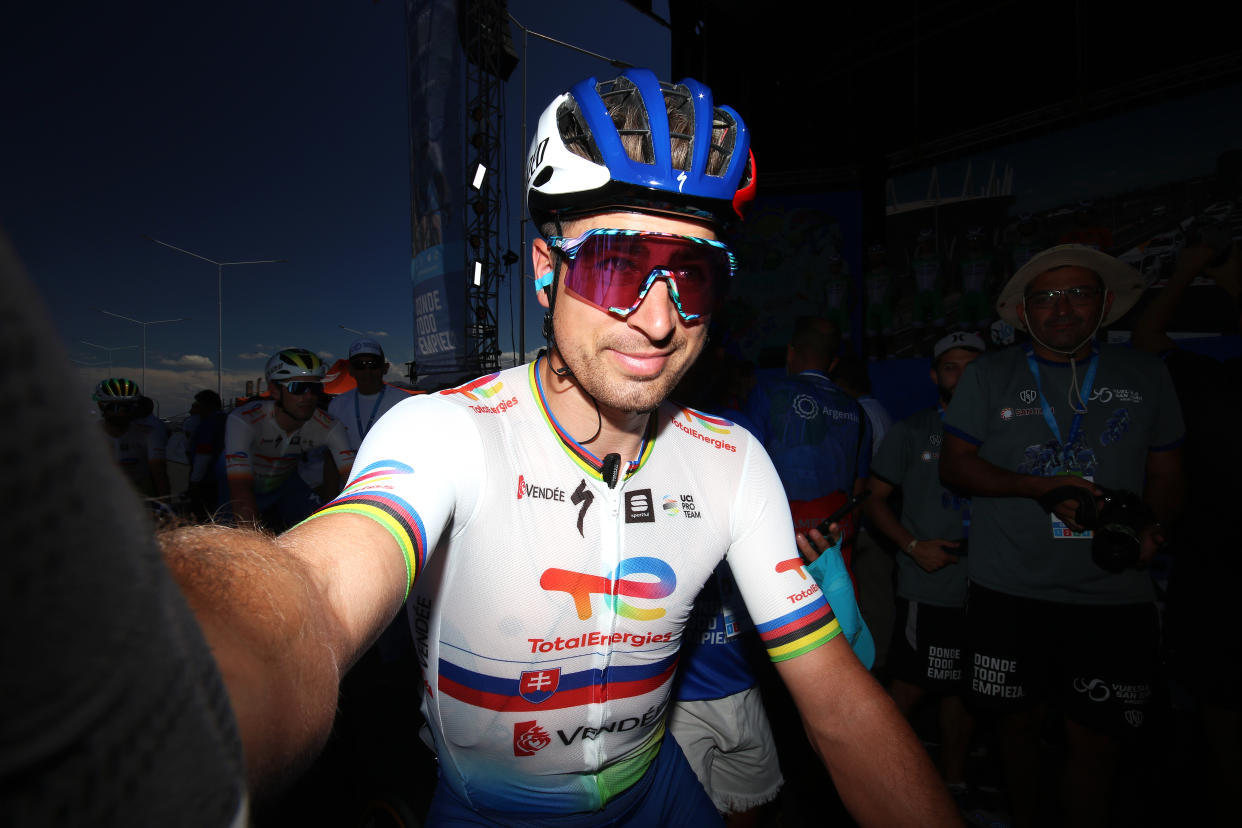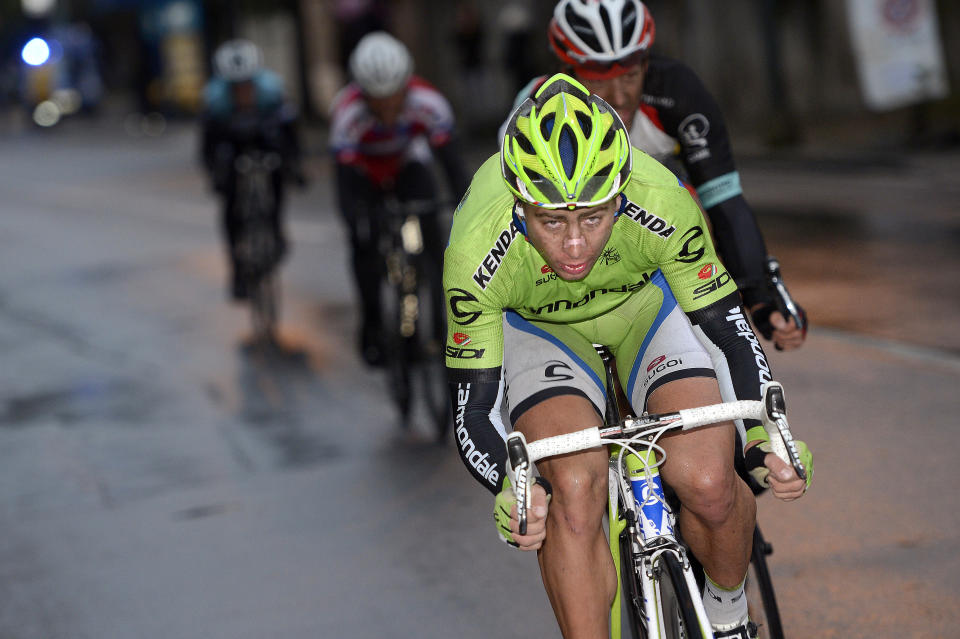‘Milan-San Remo is all or nothing’ – Peter Sagan faces last dance on the Poggio

- Oops!Something went wrong.Please try again later.
Peter Sagan will ride Milan-San Remo for the last time in his illustrious career on Saturday, still dreaming of success in the Via Roma and with few regrets about the many times he has gone close to victory.
Sagan’s palmares is laden with Classics victories, sprint victories, three world titles and a record seven Tour de France points jerseys. But Milan-San Remo has always escaped him.
“Milan-San Remo has always been a race that suits me but has always been a difficult race for me to win. But I’ve got one chance left to win it,” Sagan told Cyclingnews and other media present at Tirreno-Adriatico.
This year’s race will be Sagan’s 13th participation in the longest, most finely balanced Classic on the calendar. He has finished second twice in the last decade and fourth an incredible five times. He has nine top-ten finishes, with his worst result coming in 2022 when a mechanical before the Cipressa left him chasing all the way to San Remo.
Read more
Seeing life from a different angle – Peter Sagan faces final curtain on the road
'It’s probably the hardest race to win' - Tadej Pogacar goes again at Milan-San Remo
'A race of infinite possibilities' – But is Milan-San Remo now beyond the sprinters?
The near misses have often left Sagan saddened or even revealed some rarely seen anger. He knows he should have won that famous, shoulder-to-shoulder sprint against Michał Kwiatkowski and Julian Alaphilippe in 2017, and he could have won on a number of other occasions, including the legendary 2013 edition that was raced in the snow when Gerald Ciolek beat him in the sprint.
“I haven’t managed to win Milan-San Remo for a lot of different reasons and because every year is a different race,” Sagan explained.
“Perhaps a teammate up the road, other times perhaps I underestimated my rivals or I had a mechanical. That’s cycling, things happen.
“Losing in 2017 hurt a lot, I admit it. I felt really strong that day, but they told me information from the team car that was wrong, so I made a bad tactical decision. But as I said, Milan-San Remo is decided even in a split second and you don’t get a second chance to win.
“Milan-San Remo is also special in that sense, there so much you can’t control. If you’re the absolute strongest at the Tour of Flanders, you can win quite easily.
“Milan-San Remo is more of a lottery and everything is decided in the last five kilometres, so there’s no real time to correct any errors you make or to turn things around if you have a mechanical or a problem. Milan-San Remo is all or nothing.”

One last season for the fans
Sagan has enjoyed an intense and successful career since exploding onto the scene with two powerful sprint wins at the 2010 Paris-Nice in his debut season with Liquigas.
One green jersey gradually became seven between 2012 and 2019, one rainbow became three in Richmond, Doha and then Bergen. His victory celebrations, his deep laugh and his post comments often went viral. His contracts and Specialized personal deal became bigger and bigger, until his divorce from Bora-Hansgrohe and his move to TotalEnergies in 2022.
Even now, at 33, after two seasons hit by multiple COVID-19 cases and close to the end of his career, Sagan remains one of the stars in the peloton, with a salary to match.
Yet he is ready to retire, the fatigue of a decade of WorldTour racing and constant travelling has worn him down. He wants to take his foot off the gas, spend more time with his young son Marlon and focus on qualifying and riding the mountain bike event at the 2024 Paris Olympics. Sagan was born a mountain biker and wants to return to his roots for his last hurrah.
“I’ll stop racing at WorldTour level this season but next year I’ll still do some road races to stay fit for my other racing stuff,” he said.
“But I think it’s right for me to stop now. I didn’t just want to stay in the peloton. Some riders race on and on, or they become domestiques and pass on their experience to younger riders. I think I’ve already done that and feel it’s personally the right time for me to do something else.”
Sagan made the snap decision to announce his retirement on his 33rd birthday on January 26 at the Vuelta a San Juan. He had already decided months before but wanted to be honest with everyone for his final season.
“I think it’s only fair for everyone but especially for the fans,” he explained. “This way, they know that they can see me race for the last time in Italy, at the Classics and the Tour de France. That’s why I announced it at the start of the season, I think it’s a sign of respect towards them.
“I want my retirement to be a moment of happiness, not sadness. I remember the best moments and the wins, rather than the crashes and bad moments. I hope I’ve left my mark on the sport in the last decade. I had some fun and tried to have some fun and entertain people too.”

His own man but perhaps finally a Milan-San Remo winner?
Sagan has always been his own man, done things his own way while riding for some of the biggest teams in the peloton and winning the biggest races. He has made mistakes and fallen out with several of his rivals but tried to stay sincere.
He famously quoted Kurt Cobain in 2016, saying: “They laugh at me, because I am different. I laugh at them, because they are all the same.”
Sagan’s originality and gruff but skilled racing style arguably opened the door for the current generation of Classics riders.
Tom Pidcock can show off his descending skills on a closed road in California, Wout van Aert has Red Bull as a personal sponsor and Mathieu van der Poel races far more aggressively than previous generations because Sagan shook-up the rules of racing and behaviour.
“Sadly, I feel the sport will soon go backwards,” he said with dismay.
“Not because I’m no longer around to shake things up and be different but also because everything has become more professional and serious.
“There’s more pressure to perform, racing is becoming faster and harder, so I don’t think people will want to take risks, I don’t think they can have fun and so express themselves like I did.”
Sagan finished second on a stage of the Vuelta a San Juan behind Fernando Gaviria, but he has yet to make a mark on the 2023 season. He completed Tirreno-Adriatico anonymously but with the hope that the Italian stage race can give him the form to have a final shot at Milan-San Remo on Saturday and then in the cobbled Classics.
“Who knows, we’ll see,” Sagan says, rolling out his usual line when asked to make a prediction and responding more carefully than a bank CEO making forward-looking statements to the markets.
“Let's see how I feel on the day and let's see how the race goes. Anything could happen at Milan-San Remo, you just never know.”
Sagan’s years of riding and losing Milan-San Remo means he can actually foresee several different scenarios.
“A small group of three or four riders will go away over the Poggio, or one rider will escape like Nibali did in 2018 and Mohoric did on the descent last year. Or if everybody marks each other like crazy, then there could even be a big group sprint in the Via Roma.”
And if the stars align and Sagan wins Milan-San Remo at his last attempt?
“If I win Milan-San Remo I’ll retire straight away….” he said with his deep and happy laugh.
“No. I’m joking… Perhaps. First let's see what happens. Let’s try and win it first, then I’ll decide.”

